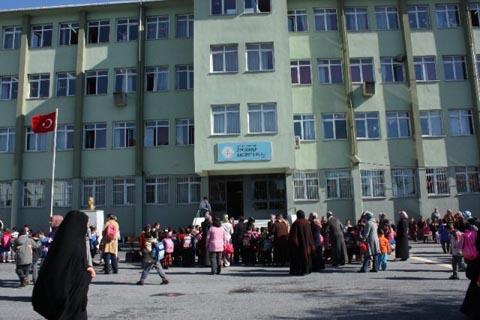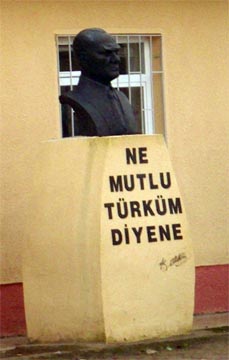Report on my teaching music multicultural in Turkish schools

School in Bagcilar/Istanbul "Ziya Gökalp Ilkögretim Okulu"
(this means: a general school with grades 1 thru 8, dedicated to Ziya Gökalp, for about 1300 students, about 55 kids per class, one of many schools in Bargcilar, part of Istanbul with almost 1 Million inhabitants)


The "ceremony" (every day before school starts).
Bağcılar is a working class suburban district of Istanbul. It is located behind Bahçelievler on the European side of the city, between the two major ring roads. Population 1970: about 8 000, 2008 about 720 000.
Sparsely populated countryside at the time of founding of the Turkish republic, bağcılar means "vine growers" in Turkish. But the district has been urbanized within the last decades. Most of the housing in Bağcılar was illegally built Gecekondu but has now been replaced by rows of cramped apartment buildings, also built with minimal regulation. It is a classic example of failed urban planning, perhaps exemplified by the fact that Bağcılar was not created as a district in its own right until 1992, by which time the original inhabitants had all left and building in the area was completely out of control. Bağcılar is now populated by recent immigrants from Anatolia, mostly young families, mostly poor, with many children. These people are struggling to survive in narrow streets of the most basic, undecorated buildings. There is little infrastructure to support the huge population, no parks, cinemas, and very few cultural or social amenities of any kind. Except one high profile white elephant: there are few trees in Bağcılar, but there is an Olympic Sports Complex. And lots of crime caused by Kurdish immigrants. Also Bağcılar has been in the news recently as families in the area are failing to send girls to school. The local council is now trying to invest in parks, cafes and other amenities but the area is so full that there is little space. Bağcılar is a right-wing stronghold. - 30% of the males and 58% of the femals are analphabetians. (From Wikipedia)
Wolfgang Martin Stroh: The students were very interested, I had the impression that they are eager to learn,
they behave very open minded, and most of them wear school-dresses. And besides, they are very musical. Boys and girls sing, sit,
dance and act together. Still about 90% oft the mothers, who bring the kids to school, wear an islamic veil. (You might discover
them in the back lane of the picture "ceremony".) When I asked the students, "who has some relatives in Germany", a
bout 60 to 70% answered "yes, I have". As most of the citicens of Bağcılar came in the 1970th
from Anatolia and the Blacksea-coast, quite many of them moved on to Germany - to Frankfurt, Köln, Hamburg, Berlin etc.
I was aware that for the future of Turkey there is only one chance: the SCHOOL as an institution of learning democracy. This means,
a school where children learn to be self determined, self conscious, sexually independent. Of course, the school is "kemalistic",
and follows some rules, which are more military then pedagogy. But nevertheless, the teachers can and do give some ideas to the students,
what it means to be a "democratic person", an enlightened citicen, a happy person.
The Bagcilar-pictures taken from the internet-presentation of the school.
School in Kapukargin/Dalaman "Kapukargin Ilkögretim Okulu"
(this means: a general school with grades 1 thru 8, for about 150 students, about 20 kids per class, it's a small school on the countryside)


Atatürk: "I am glad to be Turkish".
Dalaman is a district, as well as the central town of that district, situated on the southwestern coast of Turkey, in the Muğla Province.
Dalaman Stream (Dalaman çayı) forms much of the western border of the district. The town of Dalaman is located in the coastal plain, whereas the rest of the district – towards Fethiye district on the coast and towards the high mountains on the northern border to Denizli Province – is upland, dominated by the valleys of the Dalaman Stream's eastern tributaries. A state farm is present in Dalaman. Agriculture, particularly citrus fruits, plays an important role in the local economy, since it is situated in a fertile plain at sea level. (From Wikipedia)
Wolfgang Martin Stroh: You drive several miles through citrus-farms on the back side of a big airport, pass some moscs, and even a small "super market", and then You can see a small school building. About 8 teachers teach the 8 classes, everything is very familiar. In the mids of the classroom there is an oven to be fired by wood. The students sit along tables for four, coverd with a red cover. But, there ist not very much difference between the kids here on the countryside and within Bagcilar... they are very eager to learn, love to sing and act, and the "classical music" I presented didn't scare them at all.
The teachers are all well educated people, very interested in what I was doning (as this was quite unknown to them, as it is in Germany, too) there is not difference to Istanbul. Only, the teacher's room is extremly small, plastic chairs and a small tea pot. The first question after I had finished my classes was: "do You come again next week?"
